News – zambia hippo cull update
ZAMBIA HIPPO CULL UPDATE
RATIONALE FOR PLANNED CULL OF THOUSANDS OF HIPPOS IN ZAMBIA FLAWED?
Born Free’s recent breaking news that, in a secret move by the Zambian government, fee-paying trophy hunters are to be allowed to kill more than a thousand hippos over the next five years has been confirmed by Zambia’s Minister of Tourism and Arts, Charles Banda, in a press statement.
Zambia’s government claims that the cull, on the Luangwa River bordering Zambia’s premier safari tourism destination, South Luangwa National Park, is a bid to control numbers.
Although exact numbers have yet to be confirmed, and with original reports suggesting the proposed cull could involve as many as 2,000 animals over five years, the authorities have said they plan to allow at least 250 hippos a year to be killed.
A South African safari hunting company, Umlilo Safaris, has already started offering trophy hunters the chance to kill up to five of the hippos each on a hunting trip to Zambia. Each hunter will be charged up to $14,000 for five hippos, potentially netting millions of dollars according to Umlilo Safari’s Facebook site.
Will Travers OBE, Born Free’s President and Co-Founder, said: “Zambia’s Minister of Tourism and Arts, Charles Banda, is using much of the same flawed rationale for the proposed slaughter that the Zambian authorities used to try and justify the aborted 2016 cull. This was quickly dropped due to the strength of opposition from conservation organisations and both the national and international community, who challenged their justification for such drastic action.
“History is repeating itself because, once again, the Zambian authorities have failed to provide any scientific evidence showing an overpopulation of hippos in the Luangwa River, or to make public any data that, at least in their mind, could justify a cull.
“On the contrary, published scientific research, conducted by the Zambia Wildlife Authority (ZAWA) itself, clearly shows that previous culls of hippo in the Luangwa River did not significantly affect population size and density. Put simply, temporarily leaving to one side the serious moral and ethical considerations associated with the killing of thousands of hippo – culling has not worked as a way of controlling the hippo population in Luangwa,” Travers added.
Scientific research into factors affecting the Luangwa hippo population, published by Dr Chansa Chomba in the International Journal of Biodiversity and Conservation in 2013* when Dr Chomba headed up the Department of Research, Planning, Information and Veterinary Services for ZAWA, concluded that culls were ineffective in controlling the hippo population.
In this research, Dr Chomba, who is now a senior lecturer in the School of Agriculture and Natural Resources at Mulungushi University in Zambia, reported that ZAWA had conducted a number of hippo culling and cropping schemes since the1960s, up until the last culling programme commencing in 2005 that set out to cull more than 1,500 hippos over eight years.
Dr Chomba reported that previous efforts by ZAWA to regulate the hippo population in Luangwa using culling schemes and other management interventions had not been properly assessed. Because of that, the main factors regulating the hippo population were unknown. He also reported that data on the number of specimens culled, age structure and sex ratios from previous culling exercises had not been properly analysed.
His research, on behalf of ZAWA, aimed to assess the main factors regulating the Luangwa hippo population size over the period 1976 to 2008. Importantly, in light of the current planned cull, his research investigated the specific impact of culling over this 32-year period.
The results demonstrated that all culling programmes conducted in Luangwa since the 1960s, aimed at reducing the hippo population size, had failed because the population quickly recovered after a cull. It also reported that it was well-documented in the scientific literature that the act of culling removed excess male hippos and freed up resources for the remaining females, leading to increased births and facilitating rather than suppressing population growth rate. He concluded that hippo culling actually stimulated population growth.
In this research, Dr Chomba also reported that, over the study period of 32 years, the hippo population in Luangwa oscillated upwards and downwards in four cycles of about eight years each, with natural environmental factors collectively forming environmental resistance or limitations. This ensured that the hippo population remained within the carrying capacity band for the entire period, 1976-2008. Furthermore, he reported that since the environmental factors were not constant, but rather fluctuated from year to year, the hippo population also followed the same pattern.
As Professor Richard Kock, Professor of Wildlife Health at the Royal Veterinary College, said on 6th June 2018, the Zambian government needs to provide robust scientific data in order to try and justify the cull. Not only has it failed to do so, but now we know that its own research shows that previous hippo culls in Luangwa have not only failed to control the population but, conversely, have actually stimulated population growth. It also shows that natural environmental factors have, instead, kept the population in check.
In light of this scientific research, Born Free calls on the Zambian government to abandon plans for the cull which, some suggest seems more akin to a money-making exercise than an effective, scientifically-validated ‘animal management’ strategy.


